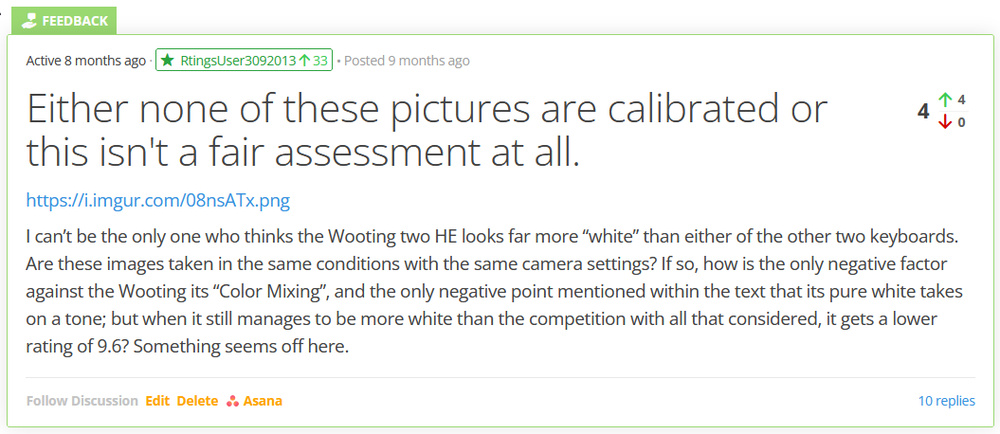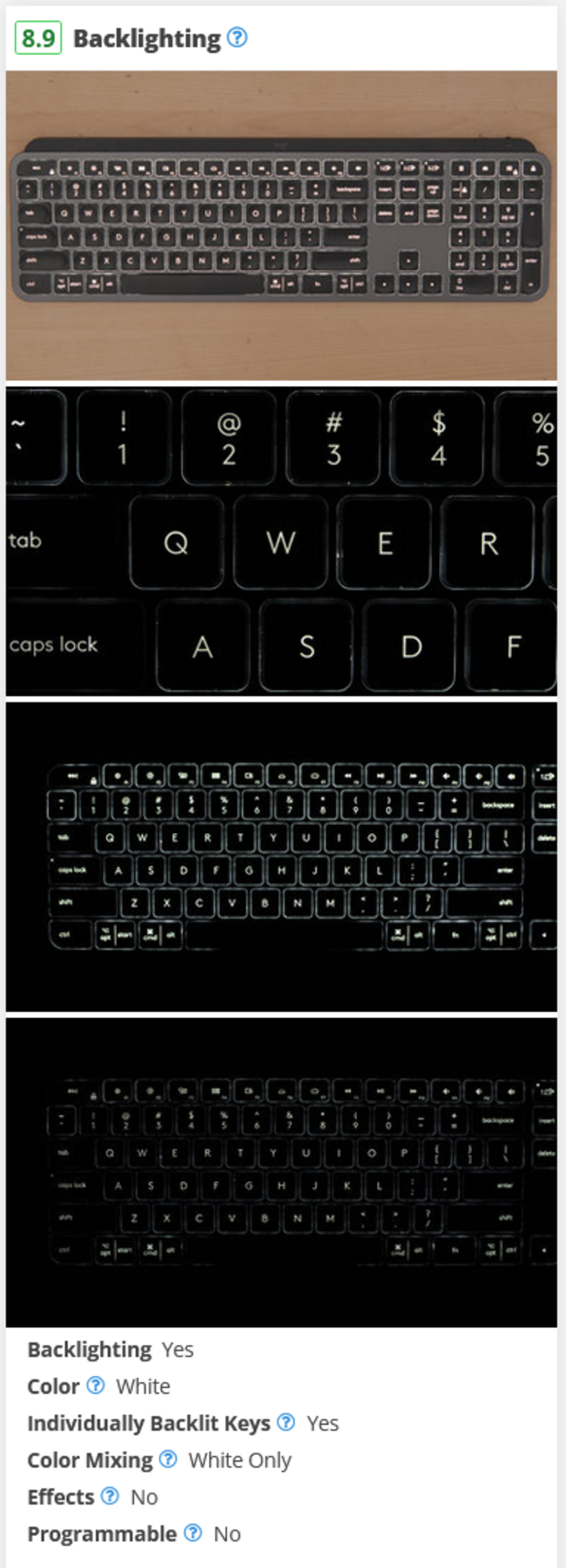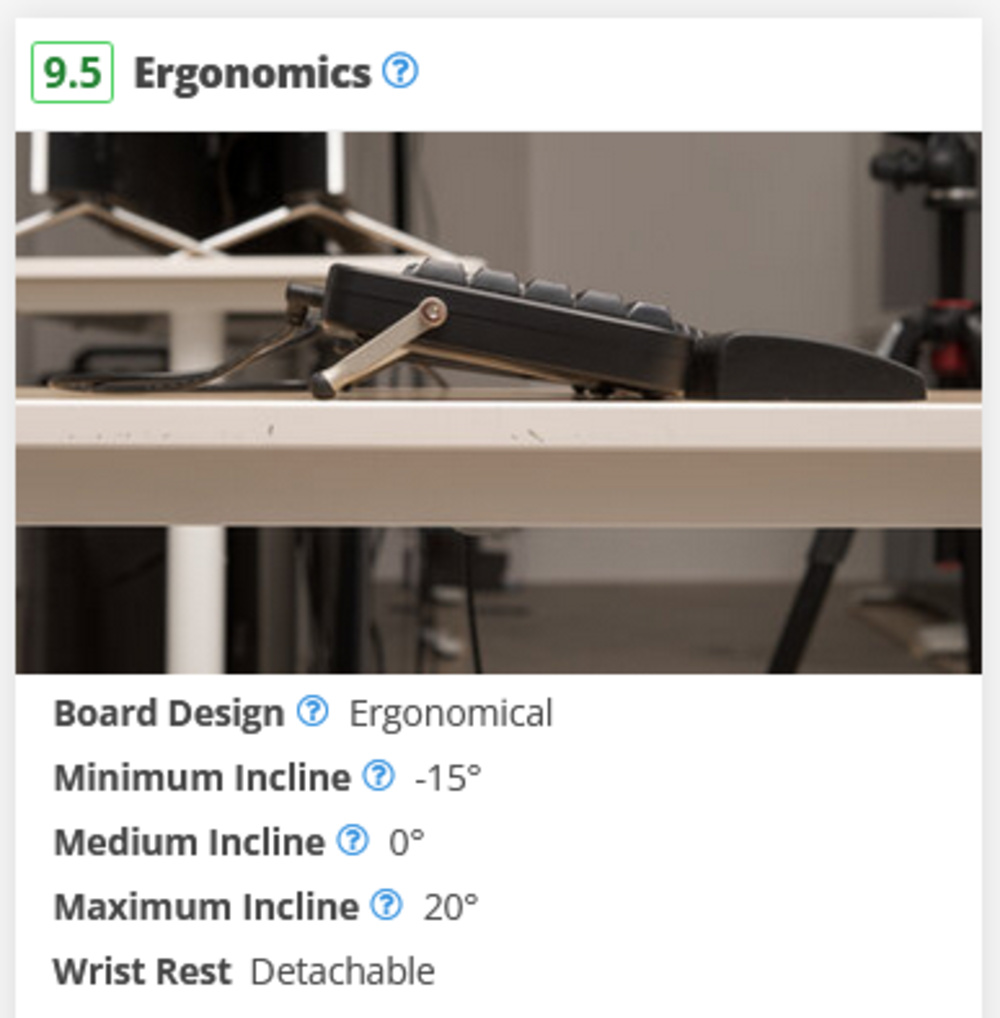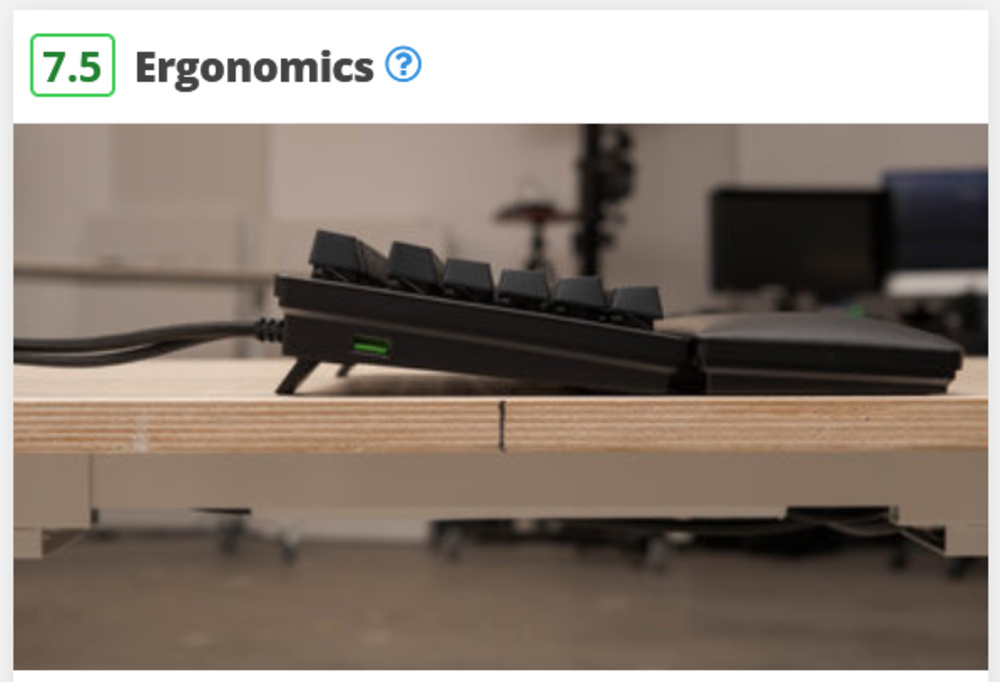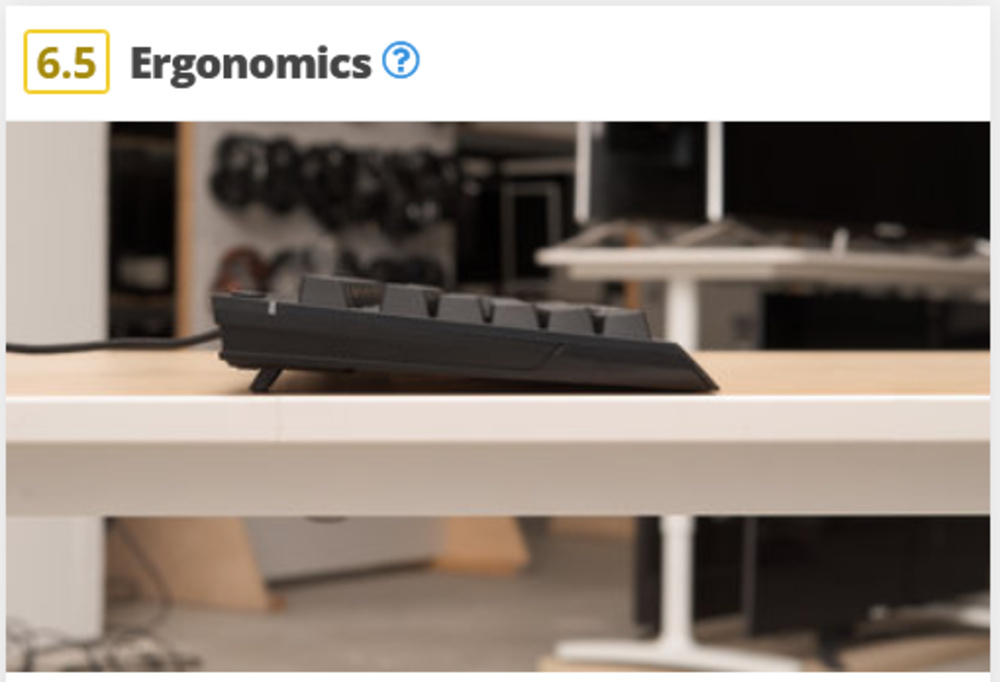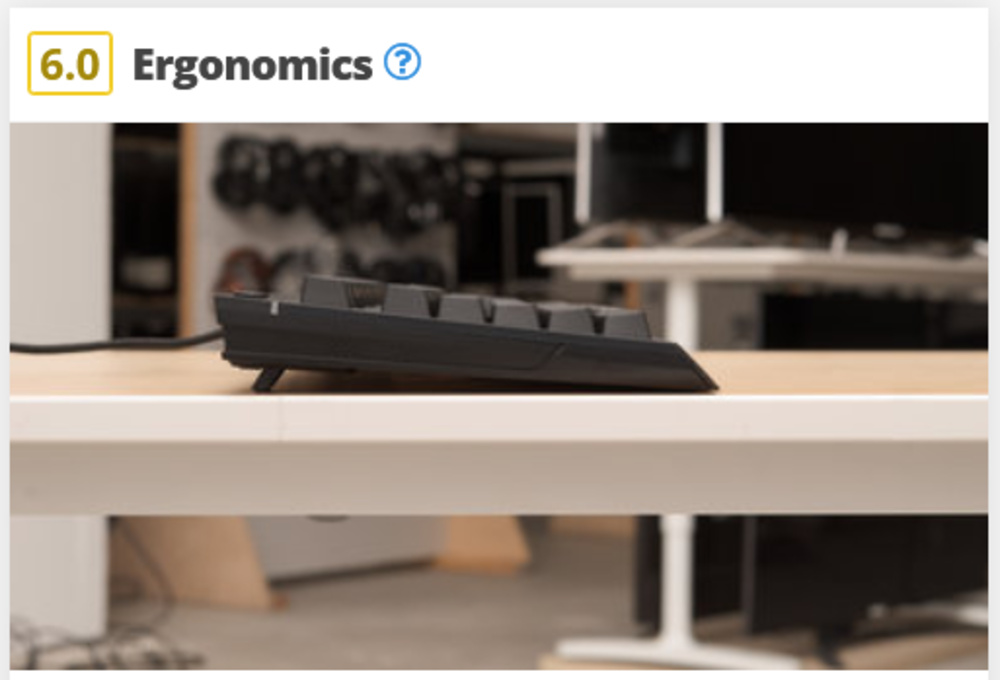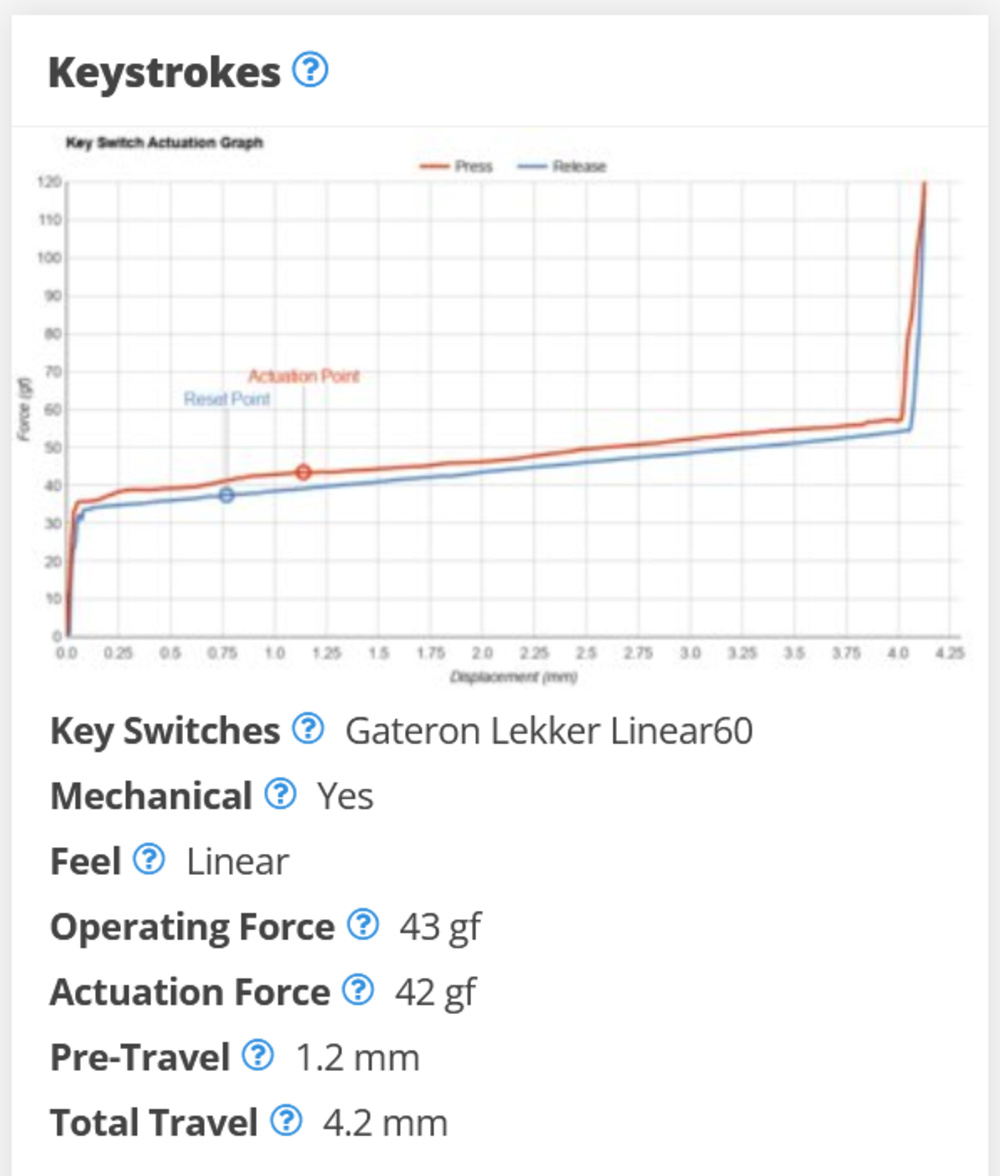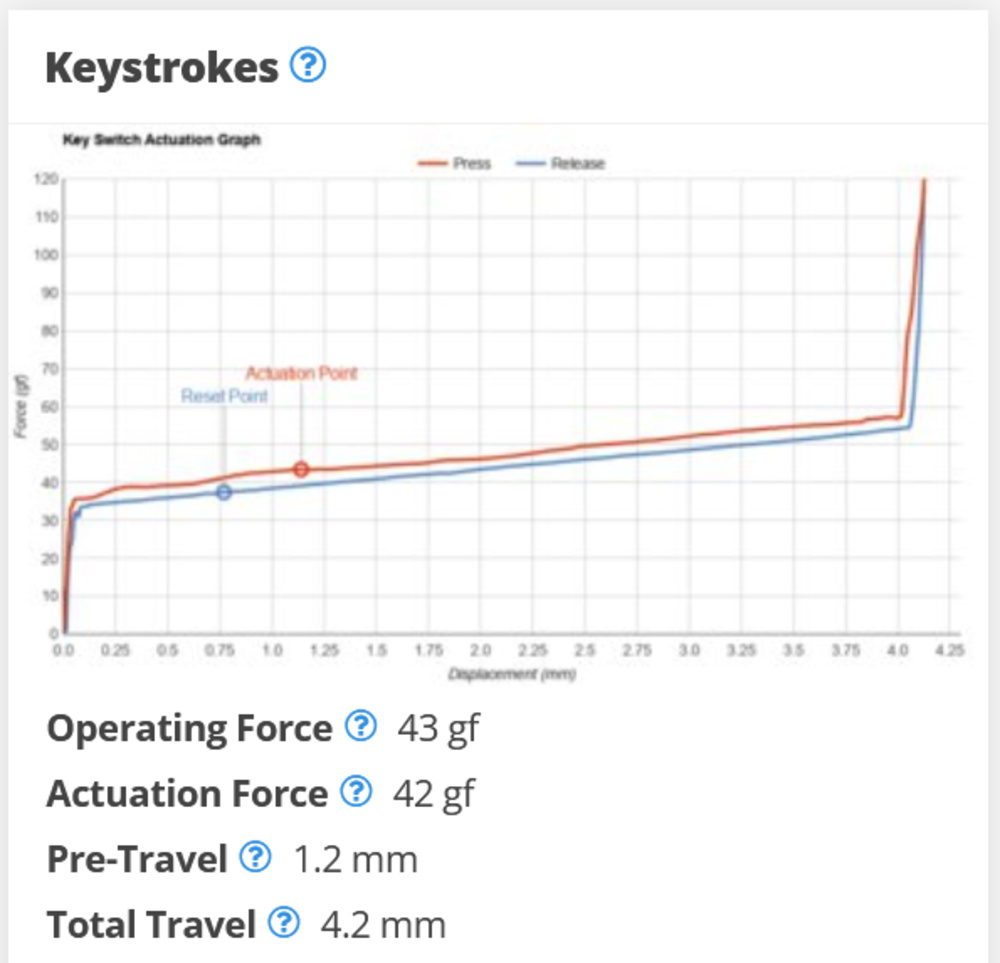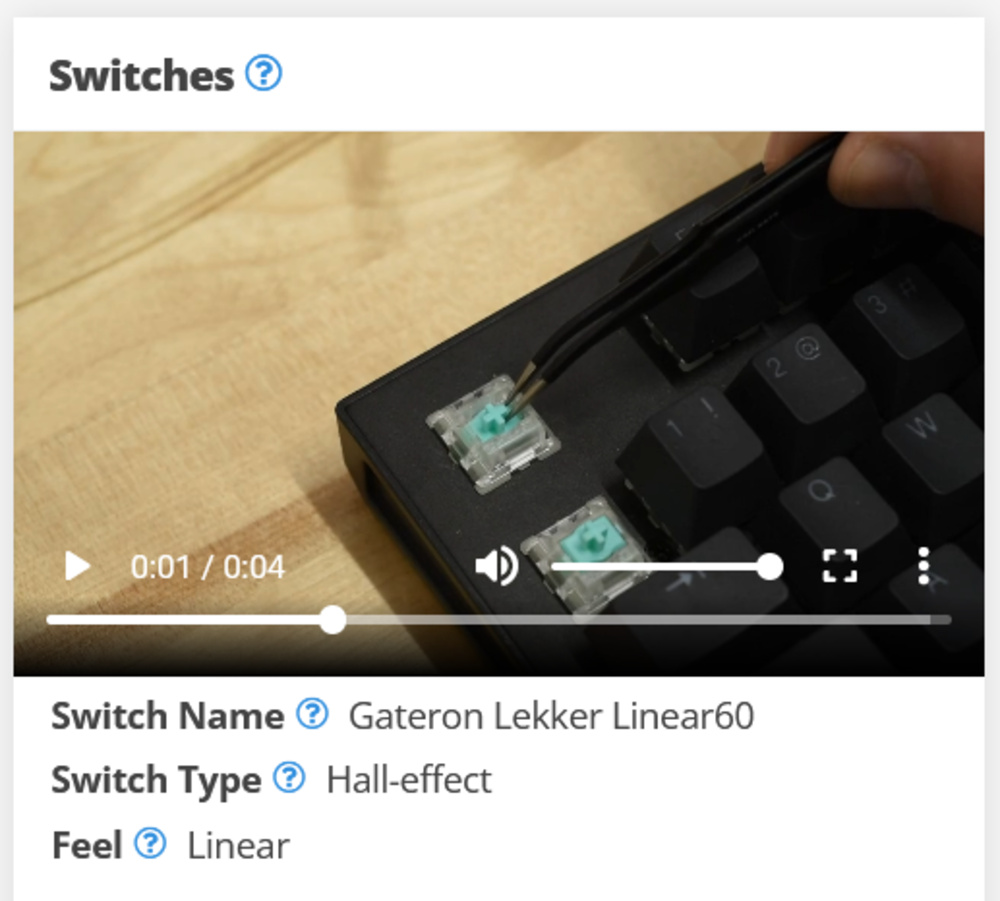See the previous 1.1 changelog.
See next 1.3 changelog.
Goal
With this update, we aim to improve how we evaluate backlighting, ergonomics, and switches. Several tests have been simplified, and new tests are more focused. Many of these changes make it easier for you to use the tools on our website to sort through and find the best keyboards for your needs.
Summary Of Changes
Below is a summary of the changes we've made with this update. More detailed information is available after this chart, and smaller changes and other investigations are detailed at the end of this page.
| Test Box | Change |
| Backlight Features |
|
| Backlight Clarity |
|
| Ergonomics |
|
| Keystrokes |
|
| Switches |
|
| Hardware Customizability |
|
Details Of Changes
Issues With Our Old Backlight Test
With our old backlighting test, we evaluated a keyboard's backlighting features and quality to determine our score, but this approach created scoring inconsistencies.
Keyboards with extensive backlight features but poor backlight clarity would receive a better score than those with limited features but good backlight clarity.
For example, the Keychron Q6 had a remarkable backlighting score, but you couldn't read any of the legends on the keys in a darkened room. This score was misleading if you were interested in buying a keyboard with legends you could see in a dark room.
Our Solution
We've decided to evaluate backlighting in two separate tests to fix this. The first one we're going to take a look at is Backlight Clarity.
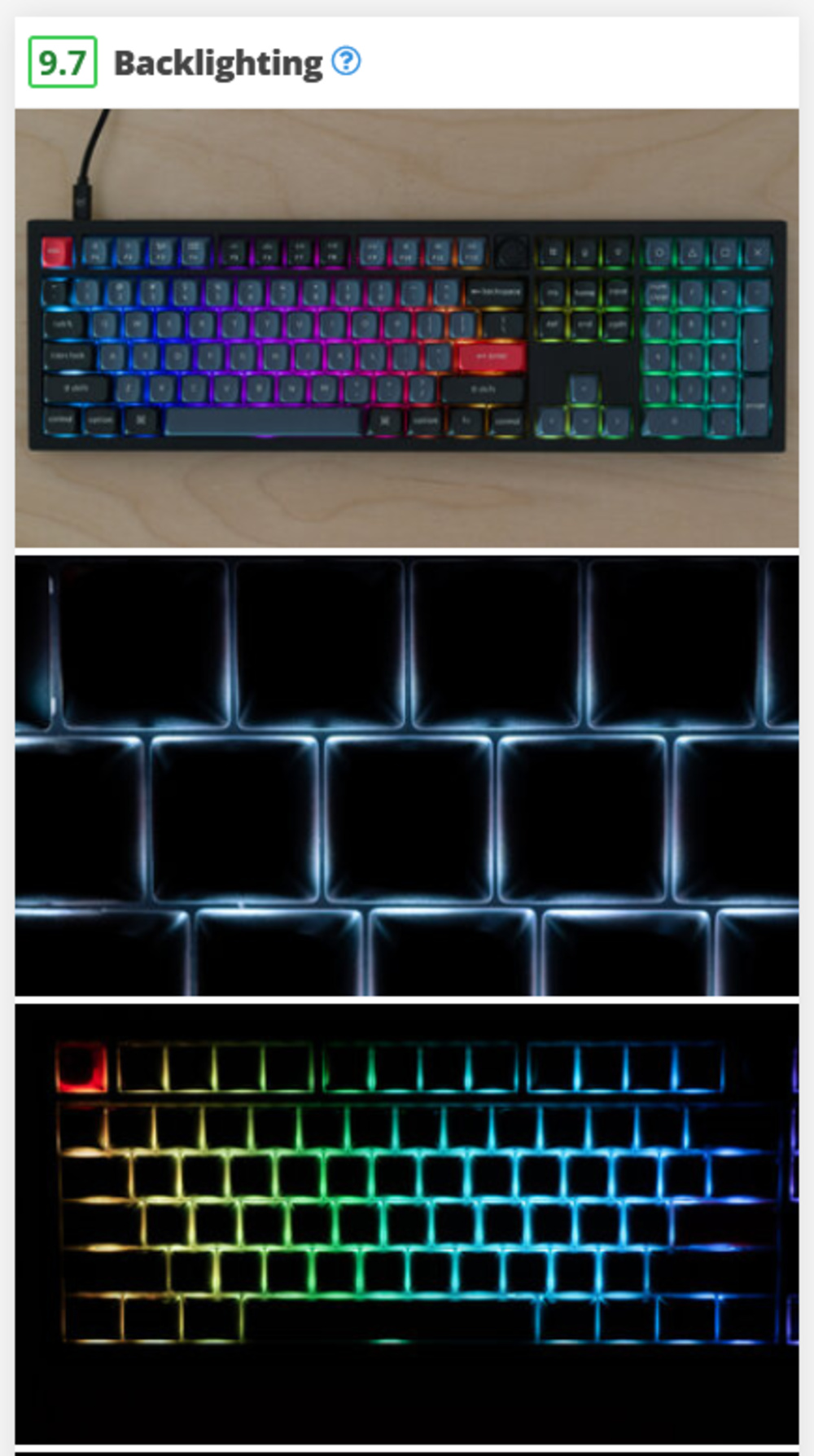
Backlight Clarity - New Test
This new test evaluates a keyboard's Backlight Clarity—or how well a keyboard's backlighting illuminates what you need to see on your keyboard.
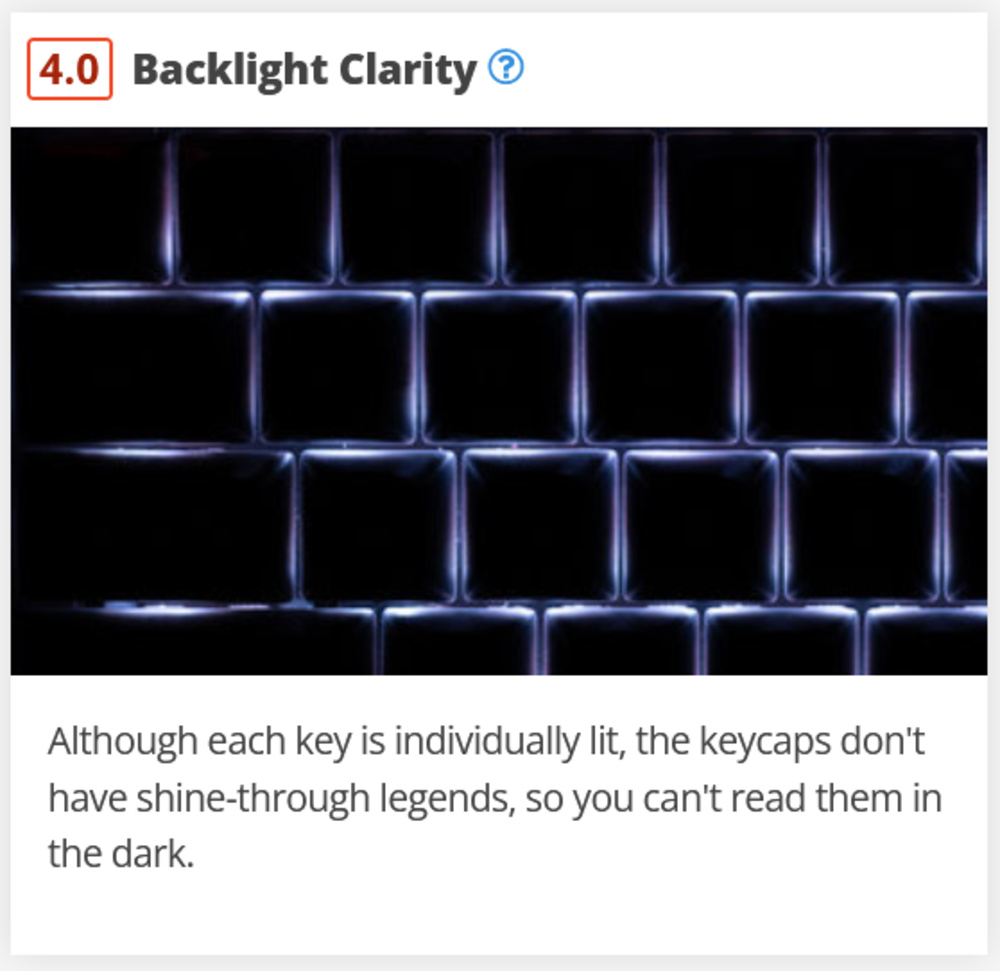 The Keychron Q6 has poor Backlight Clarity
The Keychron Q6 has poor Backlight Clarity The NXZT Function has outstanding Backlight Clarity
The NXZT Function has outstanding Backlight ClarityDoes White Light Accuracy Contribute to the Backlight Clarity Score?
If a keyboard can display white-only lighting, we ensure it's set to display white-only light for comparability. However, our score isn't influenced by the accuracy of the white lighting itself.
The score of this test is entirely determined by how clearly you can see the keys and the legends on the keys. This means a keyboard like the NXZT Function in the example above scores very well, although its white-only lighting is noticeably off-white. We know that white color accuracy is important to some people, so while it doesn't contribute to the score, it's something we note in the text.
The example above shows that the Keychron Q6 doesn't have shine-through keycaps like the NXZT Function.
In cases where the keycaps are removable and can be replaced, we'll provide an additional image with shine-through keycaps to provide as much information as possible that may be helpful for you when choosing which keyboard to buy. However, we still only score the keyboard in its stock configuration.
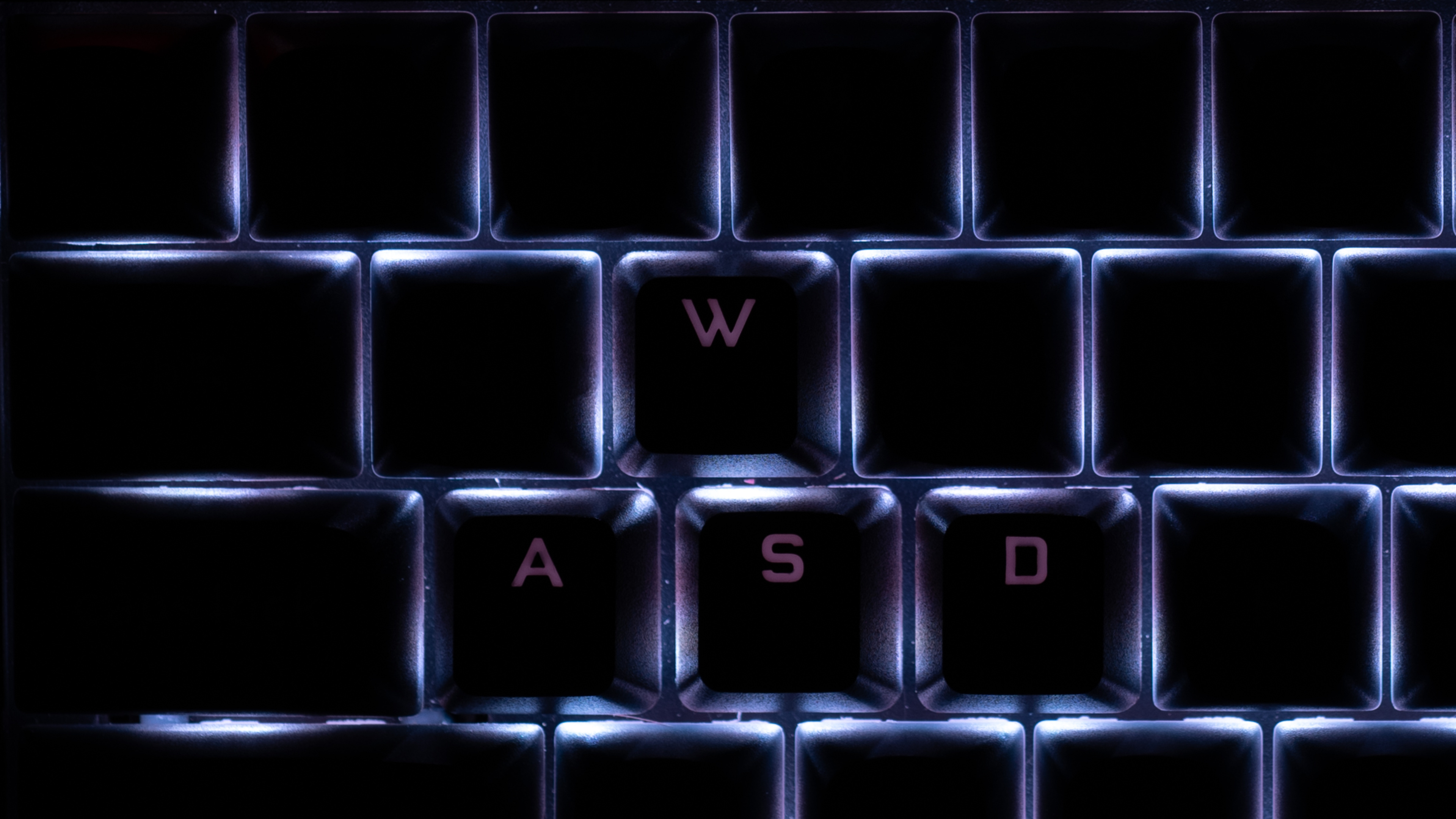
Backlight Photo Comparability
Another issue that community members pointed out was that our photographs weren't calibrated, which means they weren't helpful if you wanted to compare the brightness, color, and overall quality of backlighting between keyboards side-by-side.
Backlight Photo Comparability—Our Solution
We've made changes to our testing process to ensure backlight clarity photos are taken in a standardized way—with the same lighting conditions, camera settings, and white balancing for each photo. We've included a photo of our test setup on the right. Note that in this image, the door to the test room is open to provide enough light to show the setup, but during testing, the door is closed, and the room is dark.
- Our photo setup includes a reference light and a grey-colored reference card in the frame with the keyboard we're testing. We use the in-camera balancing to white balance against the gray card.
- We then white-balance our photo in editing software with the grey-colored reference card to produce our final calibrated image.

 The old non-calibrated white shot of the Razer Huntsman V2 Analog
The old non-calibrated white shot of the Razer Huntsman V2 Analog
 The new calibrated white shot of the Razer Huntsman V2 Analog
The new calibrated white shot of the Razer Huntsman V2 Analog
 The old non-calibrated white shot from the Wooting 2 HE
The old non-calibrated white shot from the Wooting 2 HE
 The new calibrated white shot from the Wooting 2 HE
The new calibrated white shot from the Wooting 2 HE
Backlight Features - New test
While this is a new test, it's built on the foundation of our old Backlighting test. This test is now focused exclusively on evaluating a keyboard's backlighting features.
NEW
- We've changed the names of some of our tests. The Individually Backlit Keys test is now the Per-Key Backlighting test, and the Programmable test is now the Software Controllable test.
- We've simplified our Color test, which now only indicates whether or not the Keyboard has RGB lighting.
- We've removed our Color Mixing test. But we now leave notes about color mixing as part of our new Backlight Clarity test box detailed earlier in this article.
Issues With Our Old Ergonomics Test
The question of what qualifies as an ergonomic keyboard is complex. Our previous testing methods didn't clearly recognize some of the major ergonomic features that are important to people.

Our Solution
We've added new tests for some of the most commonly requested ergonomic features. This makes filtering and sorting keyboards easier with our website's custom table tool. For example, you can create a personalized table to only display keyboards with columnar key alignment, split layouts, or between a minimum and maximum incline range.
The impact of this change may not be clear for the moment because we haven't tested many ergonomic keyboards with our newest test bench. But as more keyboards are tested and updated, the usefulness of this change will grow, and it will be easier to sort for keyboards according to the ergonomic features that interest you.
NEW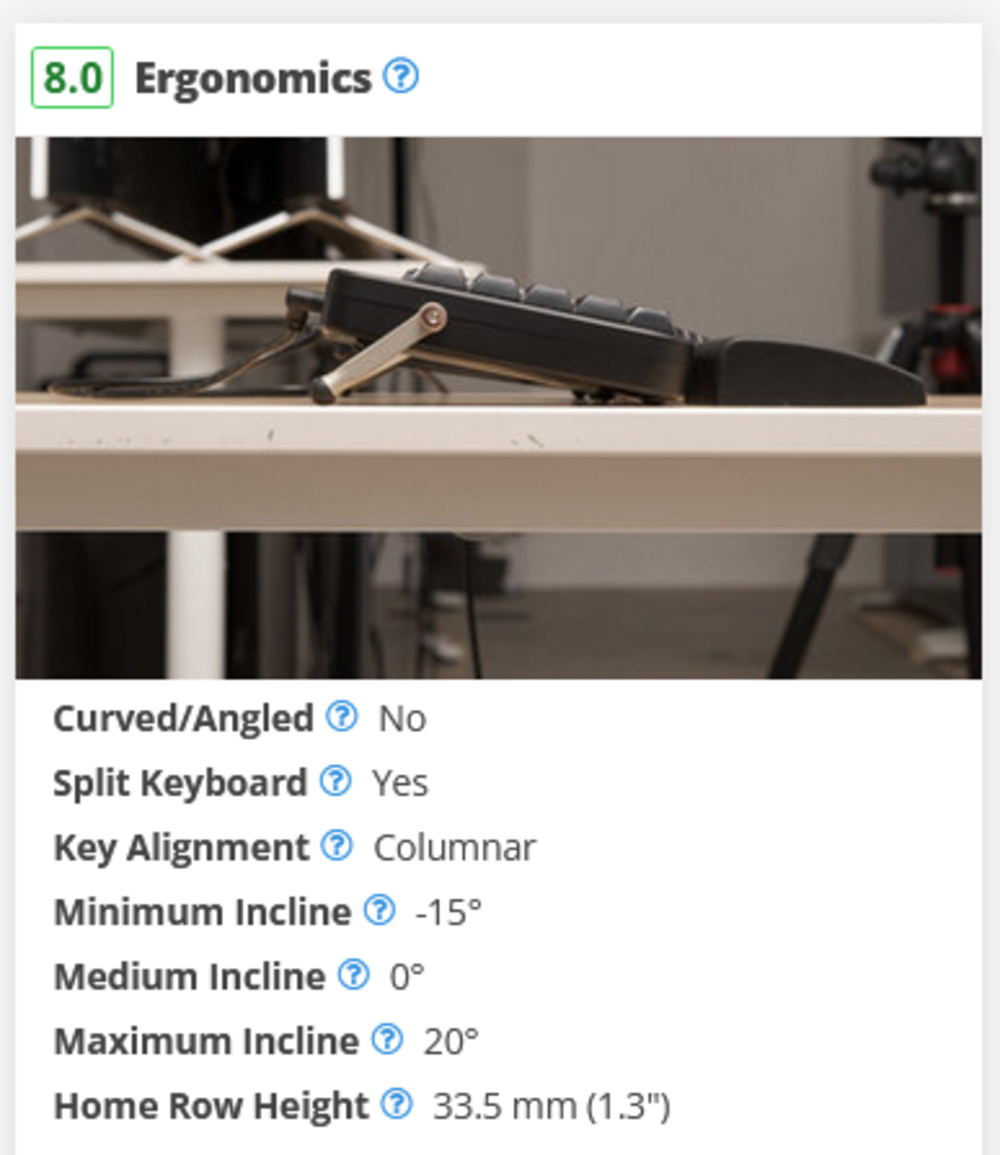
We've also added a new test that measures the height of a keyboard's home row since this indicates how steeply you need to angle your wrist upwards to reach all the keys and can be an important factor in determining if a keyboard is right for you.
When we began developing our tests, we considered using the height of the Spacebar instead. After investigating, we found that this measurement wasn't necessarily the best indicator of how steeply you need to angle your wrists to type on a particular keyboard.
Some keyboards may have similar spacebar heights but require you to angle your wrists more steeply than others.
We've included an image on the right with several examples. it's clear that while the Keychron Q6 and the GLORIOUS GMMK Pro have similar spacebar heights, the Keychron's home row height is noticeably taller, so you need to angle your wrists at a steeper angle to reach all the keys.
While a difference of only 3.5% may seem small, a few millimeters can make a significant ergonomic difference. They can be an important consideration when deciding whether to use a wrist rest with a particular keyboard.

Side profile showing the home row height of various keyboards. From left to right: The Keychron Q6, the GLORIOUS GMMK PRO, and the Corsair K100 Air.

Do We Penalize Keyboards Without Wrist Rests?
We recognize it's unlikely that we can assign ergonomics scores that everyone will agree with because everyone has different ergonomic needs and expectations. Our aim with this test bench is to get close enough to provide adequate information if ergonomics are important to you.
As community members have pointed out, our old ergonomics testing unfairly penalized keyboards that didn't include wrist rests. On our previous test bench, Keyboards that came with integrated or detachable wrist rest received higher ergonomic scores, but this wasn't helpful if you already had a wrist rest you intended to use with a keyboard or intended to purchase a wrist rest separately.
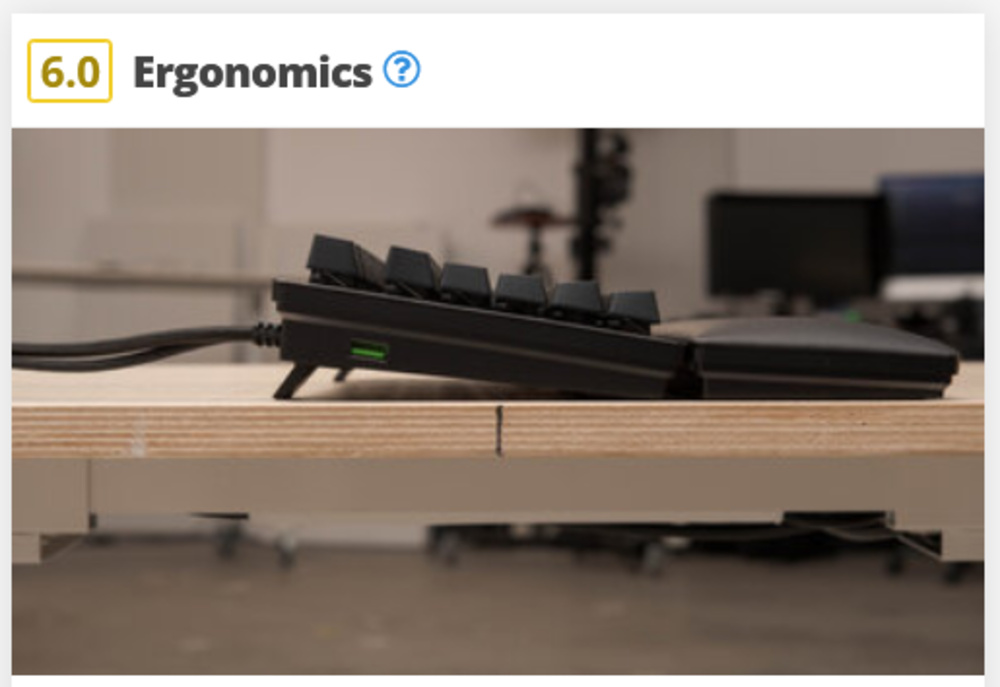
Switches - NEW TEST
Our old Keystrokes test evaluated the name, type, and feel of a keyboard's switches. It also included the keystroke force and travel measurements. Our new approach attempts to separate some of this information, provide better categorization, and a new video showing how much a switch wobbles on a given keyboard.
Our new Switch test includes basic information about a keyboard's switches, and information about a switch's force and travel measurements remain in the Keystroke test.
- We've added a new video that demonstrates switch wobble. You can see an example of one of these videos here.
- We've moved and renamed several tests from the Keystrokes test to the new Switches test.
- The Key Switches test has been renamed to Switch Name.
Our old Key Switches test was problematic because, in some cases, it identified switches by name and others by type.
We now have separate tests to identify the name and the type of the switch.
This means you can now use our table tool more effectively to sort for keyboards by switch name or switch type.
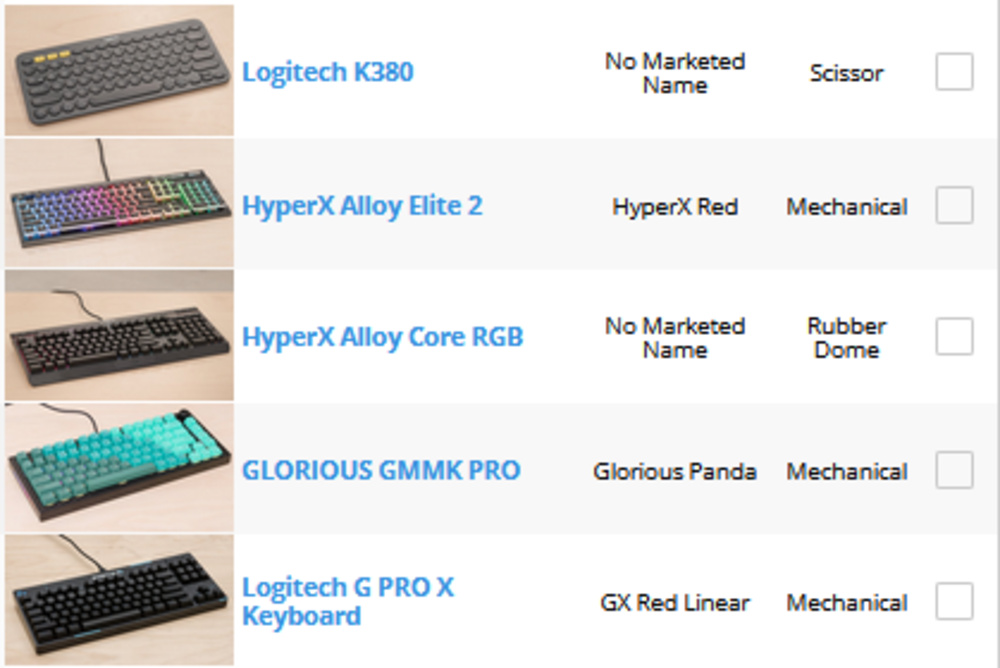
Additional investigations and changes
The changes we've explored above make up the bulk of this test bench update, but we also explored other concepts and made some additional minor changes that we've detailed below.
Switch-to-Switch Consistency
Early in our development for this test bench, we considered creating a test to evaluate how consistent all the switches are with each other on a keyboard. In other words, we wanted to determine whether the keys on a keyboard all feel and operate the same way.
We evaluated consistency across multiple metrics, including actuation force, tactile force, pre-travel, and total travel. Ultimately, we discovered that all switches were somewhat inconsistent, but there weren't clear and significant differences and conclusions to be drawn that would help make a buying decision. For example, we found that more expensive keyboards like the Keychron Q5 or the GMMK Pro using high-quality mechanical switches demonstrated similar standard deviation levels compared to much cheaper keyboards using rubber dome switches, like the Amazon Basics K4R. Based on these findings, we decided not to include this test in our reviews.
We've included a graph below showing data from some of the results of our investigation below. Note that the x-axis represents the actuation force variation from the mean. 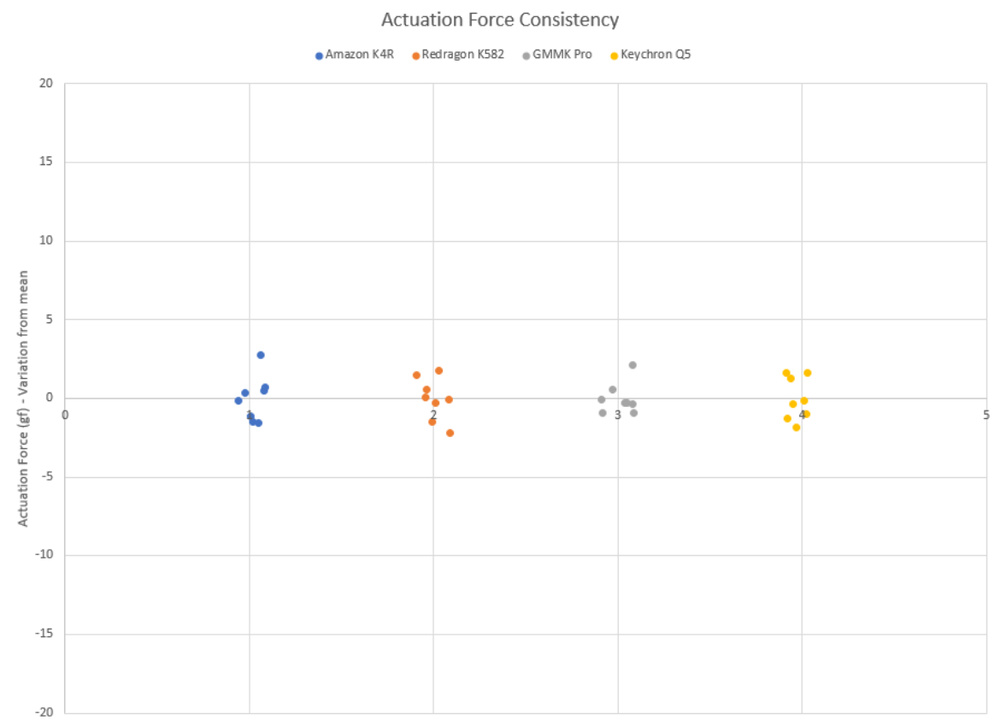
Hardware Customization Scoring Changes
Our previous test bench update introduced the Hardware Customization test. After receiving feedback, we've made a small change to this test. We now consider Cherry-style 3-pin, Cherry-style 5-pin, Other pinout, Soldered, and Non-customizable design results for our Switch PCB Socket test.
Additionally, while the Switch PCB Socket test wasn't weighted in our scoring when first introduced, it now contributes to the Hardware Customization score as penalizing keyboards that don't use standard sockets makes more sense.
Let Us Know What You Think
Your feedback is instrumental in making improvements to our testing. If you have comments, questions, or suggestions about this or any future updates, reach out to us in the discussions.
110 Keyboards Updated
We have retested popular models. The test results for the following models have been converted to the new testing methodology. However, the text might be inconsistent with the new results.
- Apple Magic Keyboard 2017
- Apple Magic Keyboard for iPad 2021
- Apple Magic Keyboard with Touch ID and Numeric Keypad
- ASUS ROG Falchion
- ASUS ROG Strix Flare II Animate
- Corsair K100 AIR
- Corsair K100 RGB
- Corsair K55 RGB
- Corsair K55 RGB PRO XT
- Corsair K60 RGB PRO Low Profile
- Corsair K65 RGB MINI
- Corsair K70 PRO MINI WIRELESS
- Corsair K70 RGB MK.2
- Corsair K70 RGB TKL
- Corsair K83 Wireless
- Corsair K95 RGB PLATINUM XT
- Dell KB216
- Drop CTRL
- Ducky One 2 Mini V1
- Ducky One 3
- Ducky Shine 7
- Dygma Raise
- Epomaker TH80 Pro
- ErgoDox EZ
- EVGA Z12
- EVGA Z15
- EVGA Z20
- GLORIOUS GMMK
- GLORIOUS GMMK 2
- GLORIOUS GMMK PRO
- HyperX Alloy Core RGB
- HyperX Alloy Elite 2
- HyperX Alloy FPS RGB
- HyperX Alloy Origins 60
- IBM Model M
- iClever Tri-Folding Keyboard BK08
- IQUNIX F97
- Keychron C2
- Keychron K10
- Keychron K3 (Version 2)
- Keychron K8 Pro [K2 Pro, K3 Pro, K4 Pro, etc.]
- Keychron Q Pro Series [Q1 Pro, Q2 Pro, etc.]
- Keychron Q6
- Keychron S Series
- Keychron V Series
- Kinesis Freestyle Edge RGB
- Leopold FC900R
- Logitech Combo Touch
- Logitech ERGO K860
- Logitech G PRO Keyboard
- Logitech G PRO X Keyboard
- Logitech G213 Prodigy
- Logitech G413 SE
- Logitech G512 Special Edition
- Logitech G513
- Logitech G613 LIGHTSPEED
- Logitech G715
- Logitech G815 LIGHTSYNC RGB
- Logitech G910 Orion Spark
- Logitech G915 LIGHTSPEED
- Logitech K380
- Logitech K400 Plus
- Logitech K585
- Logitech K780
- Logitech K845
- Logitech MX Keys
- Logitech MX Mechanical
- Logitech Signature K650
- Microsoft Bluetooth Keyboard
- Microsoft Sculpt Ergonomic Keyboard
- Microsoft Surface Ergonomic Keyboard
- Microsoft Surface Keyboard
- Mountain Everest Max
- NuPhy Air75
- NuPhy Halo96 [Halo65, Halo75]
- NZXT Function
- Obinslab Anne Pro 2
- Razer BlackWidow
- Razer BlackWidow Elite
- Razer BlackWidow V3
- Razer BlackWidow V3 Pro
- Razer BlackWidow V4 Pro
- Razer Cynosa V2
- Razer DeathStalker V2 Pro
- Razer Huntsman
- Razer Huntsman Elite
- Razer Huntsman Mini Analog
- Razer Huntsman Tournament Edition
- Razer Huntsman V2
- Razer Huntsman V2 Analog
- Razer Ornata Chroma
- Razer Ornata V2
- Razer Ornata V3
- Razer Pro Type Ultra
- Redragon K552 KUMARA RGB
- ROCCAT Pyro
- ROCCAT Vulcan II Max/Mini
- ROYAL KLUDGE RK61
- SteelSeries Apex 3
- SteelSeries Apex 5
- SteelSeries Apex 7 TKL
- SteelSeries Apex 9
- SteelSeries Apex Pro
- SteelSeries Apex Pro Mini Wireless
- SteelSeries Apex Pro TKL (2023)
- Varmilo VA87M
- Wooting 60HE
- Wooting two HE
- ZAGG Pro Keys
- ZSA Moonlander
